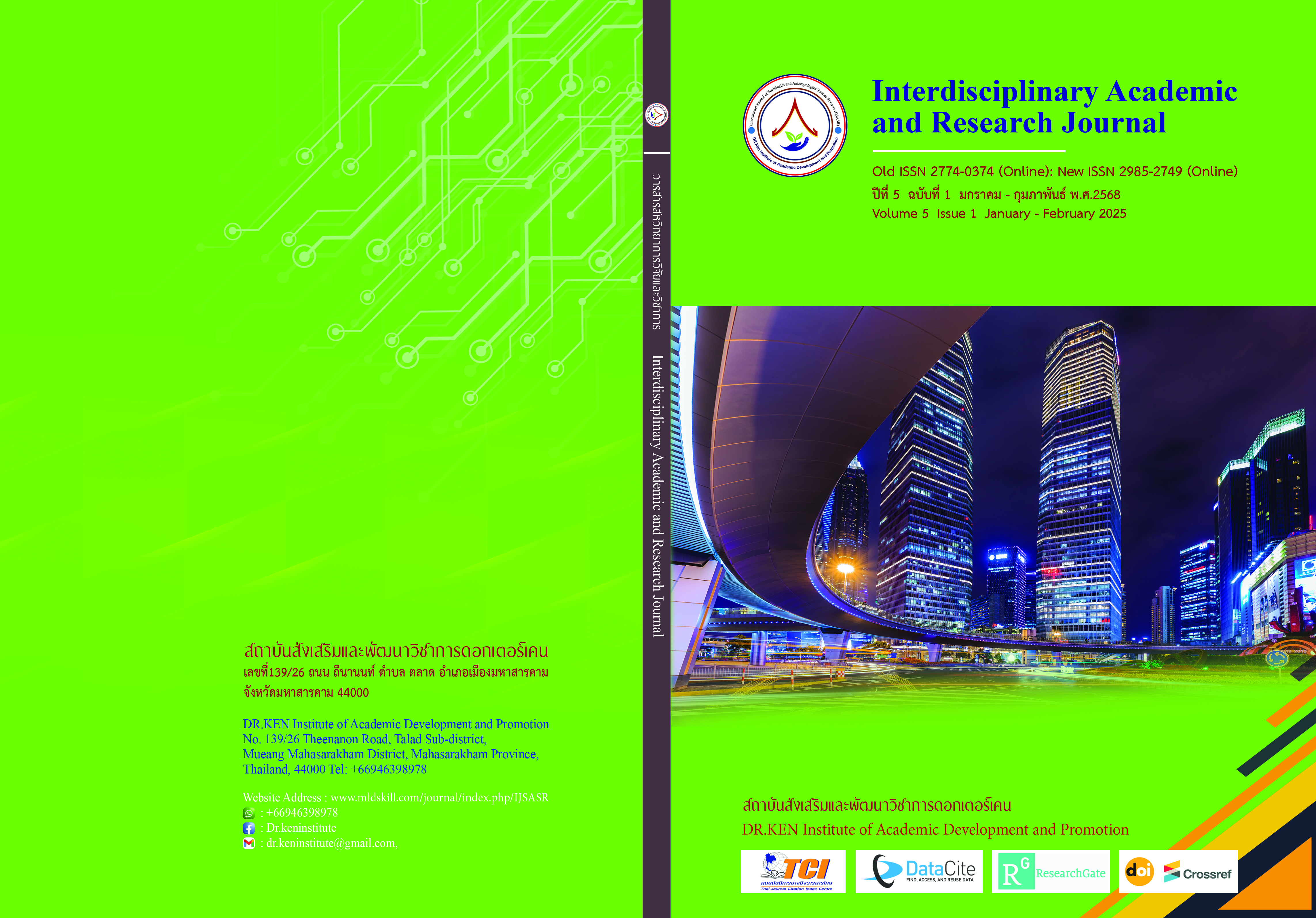Home Economics in Adding Value to Agricultural Products
DOI:
https://doi.org/10.60027/iarj.2025.280529Keywords:
Home economics, Value added, Agricultural product, Fried chiliAbstract
Background and Aims: The Academic and Professional Services Project for the Chaiyaphum Community, implemented by Ramkhamhaeng University, organized a workshop to add value to agricultural products, specifically focusing on training and demonstrating the production of fried chili products. Following the project, the researchers, as instructors and project leaders, conducted a study to use the findings for the development and improvement of the project in the next fiscal year. The research objectives were: (1) to evaluate the academic and professional services project for the Chaiyaphum community on the topic "Agricultural Product Processing (Fried Chili)" and (2) to study the trainees' perspectives on adding value to fried chili products.
Methodology: The target group consisted of 30 participants from Chaiyaphum province who attended the workshop. Data were collected using a 5-level Likert scale questionnaire. The statistical methods used for data analysis included frequency, percentage, mean, and standard deviation.
Results: The research findings indicated that: (1) The overall satisfaction with the academic and professional services project for the Chaiyaphum community on the topic "Agricultural Product Processing (Fried Chili)" was at the highest level. Satisfaction with input factors was at a high level, the process aspect at the highest level, and the output aspect at the highest level. (2) The overall satisfaction with the trainees' perspectives on adding value to fried chili products was at the highest level.
Conclusion: The "Academic and Professional Services Project for the Chaiyaphum Community on the topic 'Agricultural Product Processing (Fried Chili)'" achieved its goals in terms of input factors, process, and outcomes, with trainees perceiving the workshop as effective in adding value to fried chili products.
References
คณะศึกษาศาสตร์ มหาวิทยาลัยรามคำแหง. (2563). แผนกําหนดการศึกษา โครงสร้างหลักสูตร เทียบโอนหน่วยกิต. Retrieved May 30, 2024, from: https://www.ru.ac.th/th/Center_study_plan /15/03-4
ชุติเดช สุวรรณมณี. (2566). การพัฒนากลยุทธ์การบริการวิชาการแก่สังคมของมหาวิทยาลัยมหามกุฏราชวิทยาลัย. วารสารพุทธสังคมวิทยาปริทรรศน์, 8(2), 159-179.
ทรงยุทธ ต้นวัน และรัชตาพร บุญกอง. (2566). การพัฒนาผลิตภัณฑ์เชิงสร้างสรรค์ด้านการแปรรูปอาหารเพื่อสุขภาพ จากภูมิปัญญาท้องถิ่นของกลุ่มวิสาหกิจชุมชนในกลุ่มจังหวัดสนุก (สกลนคร นครพนม มุกดาหาร). วารสารสังคมศาสตร์และวัฒนธรรม, 7(1), 112-126.
ประทุมพร วีระสุข. (2563). การบริการวิชาการเพื่อการพัฒนาท้องถิ่นของสำนักวิทยบริการและเทคโนโลยีสารสนเทศ มหาวิทยาลัยราชภัฏกลุ่มภาคใต้. วิทยานิพนธ์ปริญญามหาบัณฑิต: มหาวิทยาลัยสุโขทัย ธรรมาธิราช.
มหาวิทยาลัยรามคำแหง สาขาวิทยบริการเฉลิมพระเกียรติ จังหวัดชัยภูมิ. (2567). ประวัติความเป็นมา. Retrieved May 29, 2024, from: http://www.chaiyaphum.ru.ac.th/index.php
มหาวิทยาลัยรามคำแหง. (2563). รายงานผลการประเมินคุณภาพการศึกษาภายในหลักสูตรเศรษฐศาสตรบัณฑิต ระดับปริญญาตรี คณะเศรษฐศาสตร์. Retrieved May 31, 2024, from: http://www.eco.ru.ac.th/images/document/quality/P2.pdf
มหาวิทยาลัยรามคำแหง. (2567). วิสัยทัศน์และพันธกิจ. Retrieved May 31, 2024, from: https://www.ru.ac.th/th/AboutUs/page?view=Vision
สุนทร ปัญญะพงษ์, อัญชลี ชัยศรี, ทัศไนวรรณ ดวงมาลา และอัญชิรญา จันทรปิฎก. (2566). ปัจจัยสู่ความสำเร็จของกลุ่มวิสาหกิจชุมชนเกษตรผสมผสานบ้านไทรงาม ตำบลนาเสียว อำเภอเมือง จังหวัดชัยภูมิ. วารสารวิชาการ มจร บุรีรัมย์, 8(2), 39-51.
อินทุราภรณ์ มงคลขจรกิตติ และอรรถ อภินนท์ธีระศักดา. (2562). การพัฒนาศักยภาพและกระบวนการผลิตของเครือข่ายวิสาหกิจชุมชนเกษตรอินทรีย์วิถีชัยภูมิ.วารสารบัณฑิตศึกษามหาจุฬาขอนแก่น, 6(2), 169-181.
Babcock, B. A., & Clemens, R. (2004). Geographical indications and property rights: Protecting value-added agricultural products. Iowa Ag Review, 10(4), 4-7.
Barham, E., Lind, D., Jett, L., & Stewart, K. (2015). Regional foods and rural development: What is the role of value-added agriculture? Journal of Rural Social Sciences, 30(1), 25-46.
Bushnell, D. S. (1990). Input, process, output: a model for evaluating training. Training & Development Journal, 44(3), 41-43.
Duarte, P., Silva, S. C., Roza, A. S., & Dias, J. C. (2024). Enhancing consumer purchase intentions for sustainable packaging products: An in-depth analysis of key determinants and strategic insights. Sustainable Futures, 7, 1-10.
Garcia-Garcia, G., Stone, J., & Rahimifard, S. (2017). Opportunities for waste valorization in the food industry – A case study with four UK food manufacturers. Journal of Cleaner Production, 118, 276-286.
Ilbery, B., & Maye, D. (2005). Alternative (shorter) food supply chains and specialist livestock products in the Scottish-English borders. Environment and Planning A, 37(5), 823-844.
Kostanjevec, S., & Kozina, F. L. (2021). Home Economics Education as Needed in the 21st Century. Center for Educational Policy Studies Journal, 11(4), 7-11.
Pomarici, E., & Vecchio, R. (2014). Millennial generation attitudes to sustainable wine: An exploratory study on Italian consumers. Journal of Cleaner Production, 66, 537-545.
Subiyakto, A. & Ahlan, A. R. (2014). Implementation of Input-Process-Output Model for Measuring Information System Project Success. TELKOMNIKA Indonesian Journal of Electrical Engineering, 12(7), 4893 – 4899.
Vasileiadis, T., Tzotzis, A., Tzetzis, D., & Kyratsis, P. (2019). Combining product and packaging design for increased added value and customer satisfaction. Journal of Graphic Engineering and Design, 10(2), 5-15.
Downloads
Published
How to Cite
Issue
Section
License
Copyright (c) 2025 Interdisciplinary Academic and Research Journal

This work is licensed under a Creative Commons Attribution-NonCommercial-NoDerivatives 4.0 International License.
Copyright on any article in the Interdisciplinary Academic and Research Journal is retained by the author(s) under the under the Creative Commons Attribution-NonCommercial-NoDerivatives 4.0 International License. Permission to use text, content, images, etc. of publication. Any user to read, download, copy, distribute, print, search, or link to the full texts of articles, crawl them for indexing, pass them as data to software, or use them for any other lawful purpose. But do not use it for commercial use or with the intent to benefit any business.
















.png)


